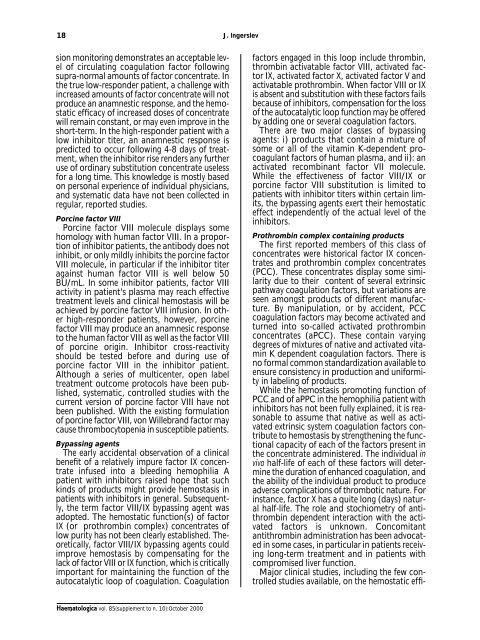Haematologica 2000;85:supplement to no. 10 - Supplements ...
Haematologica 2000;85:supplement to no. 10 - Supplements ...
Haematologica 2000;85:supplement to no. 10 - Supplements ...
Create successful ePaper yourself
Turn your PDF publications into a flip-book with our unique Google optimized e-Paper software.
18<br />
J. Ingerslev<br />
sion moni<strong>to</strong>ring demonstrates an acceptable level<br />
of circulating coagulation fac<strong>to</strong>r following<br />
supra-<strong>no</strong>rmal amounts of fac<strong>to</strong>r concentrate. In<br />
the true low-responder patient, a challenge with<br />
increased amounts of fac<strong>to</strong>r concentrate will <strong>no</strong>t<br />
produce an anamnestic response, and the hemostatic<br />
efficacy of increased doses of concentrate<br />
will remain constant, or may even improve in the<br />
short-term. In the high-responder patient with a<br />
low inhibi<strong>to</strong>r titer, an anamnestic response is<br />
predicted <strong>to</strong> occur following 4-8 days of treatment,<br />
when the inhibi<strong>to</strong>r rise renders any further<br />
use of ordinary substitution concentrate useless<br />
for a long time. This k<strong>no</strong>wledge is mostly based<br />
on personal experience of individual physicians,<br />
and systematic data have <strong>no</strong>t been collected in<br />
regular, reported studies.<br />
Porcine fac<strong>to</strong>r VIII<br />
Porcine fac<strong>to</strong>r VIII molecule displays some<br />
homology with human fac<strong>to</strong>r VIII. In a proportion<br />
of inhibi<strong>to</strong>r patients, the antibody does <strong>no</strong>t<br />
inhibit, or only mildly inhibits the porcine fac<strong>to</strong>r<br />
VIII molecule, in particular if the inhibi<strong>to</strong>r titer<br />
against human fac<strong>to</strong>r VIII is well below 50<br />
BU/mL. In some inhibi<strong>to</strong>r patients, fac<strong>to</strong>r VIII<br />
activity in patient's plasma may reach effective<br />
treatment levels and clinical hemostasis will be<br />
achieved by porcine fac<strong>to</strong>r VIII infusion. In other<br />
high-responder patients, however, porcine<br />
fac<strong>to</strong>r VIII may produce an anamnesic response<br />
<strong>to</strong> the human fac<strong>to</strong>r VIII as well as the fac<strong>to</strong>r VIII<br />
of porcine origin. Inhibi<strong>to</strong>r cross-reactivity<br />
should be tested before and during use of<br />
porcine fac<strong>to</strong>r VIII in the inhibi<strong>to</strong>r patient.<br />
Although a series of multicenter, open label<br />
treatment outcome pro<strong>to</strong>cols have been published,<br />
systematic, controlled studies with the<br />
current version of porcine fac<strong>to</strong>r VIII have <strong>no</strong>t<br />
been published. With the existing formulation<br />
of porcine fac<strong>to</strong>r VIII, von Willebrand fac<strong>to</strong>r may<br />
cause thrombocy<strong>to</strong>penia in susceptible patients.<br />
Bypassing agents<br />
The early accidental observation of a clinical<br />
benefit of a relatively impure fac<strong>to</strong>r IX concentrate<br />
infused in<strong>to</strong> a bleeding hemophilia A<br />
patient with inhibi<strong>to</strong>rs raised hope that such<br />
kinds of products might provide hemostasis in<br />
patients with inhibi<strong>to</strong>rs in general. Subsequently,<br />
the term fac<strong>to</strong>r VIII/IX bypassing agent was<br />
adopted. The hemostatic function(s) of fac<strong>to</strong>r<br />
IX (or prothrombin complex) concentrates of<br />
low purity has <strong>no</strong>t been clearly established. Theoretically,<br />
fac<strong>to</strong>r VIII/IX bypassing agents could<br />
improve hemostasis by compensating for the<br />
lack of fac<strong>to</strong>r VIII or IX function, which is critically<br />
important for maintaining the function of the<br />
au<strong>to</strong>catalytic loop of coagulation. Coagulation<br />
fac<strong>to</strong>rs engaged in this loop include thrombin,<br />
thrombin activatable fac<strong>to</strong>r VIII, activated fac<strong>to</strong>r<br />
IX, activated fac<strong>to</strong>r X, activated fac<strong>to</strong>r V and<br />
activatable prothrombin. When fac<strong>to</strong>r VIII or IX<br />
is absent and substitution with these fac<strong>to</strong>rs fails<br />
because of inhibi<strong>to</strong>rs, compensation for the loss<br />
of the au<strong>to</strong>catalytic loop function may be offered<br />
by adding one or several coagulation fac<strong>to</strong>rs.<br />
There are two major classes of bypassing<br />
agents: i) products that contain a mixture of<br />
some or all of the vitamin K-dependent procoagulant<br />
fac<strong>to</strong>rs of human plasma, and ii): an<br />
activated recombinant fac<strong>to</strong>r VII molecule.<br />
While the effectiveness of fac<strong>to</strong>r VIII/IX or<br />
porcine fac<strong>to</strong>r VIII substitution is limited <strong>to</strong><br />
patients with inhibi<strong>to</strong>r titers within certain limits,<br />
the bypassing agents exert their hemostatic<br />
effect independently of the actual level of the<br />
inhibi<strong>to</strong>rs.<br />
Prothrombin complex containing products<br />
The first reported members of this class of<br />
concentrates were his<strong>to</strong>rical fac<strong>to</strong>r IX concentrates<br />
and prothrombin complex concentrates<br />
(PCC). These concentrates display some similarity<br />
due <strong>to</strong> their content of several extrinsic<br />
pathway coagulation fac<strong>to</strong>rs, but variations are<br />
seen amongst products of different manufacture.<br />
By manipulation, or by accident, PCC<br />
coagulation fac<strong>to</strong>rs may become activated and<br />
turned in<strong>to</strong> so-called activated prothrombin<br />
concentrates (aPCC). These contain varying<br />
degrees of mixtures of native and activated vitamin<br />
K dependent coagulation fac<strong>to</strong>rs. There is<br />
<strong>no</strong> formal common standardization available <strong>to</strong><br />
ensure consistency in production and uniformity<br />
in labeling of products.<br />
While the hemostasis promoting function of<br />
PCC and of aPPC in the hemophilia patient with<br />
inhibi<strong>to</strong>rs has <strong>no</strong>t been fully explained, it is reasonable<br />
<strong>to</strong> assume that native as well as activated<br />
extrinsic system coagulation fac<strong>to</strong>rs contribute<br />
<strong>to</strong> hemostasis by strengthening the functional<br />
capacity of each of the fac<strong>to</strong>rs present in<br />
the concentrate administered. The individual in<br />
vivo half-life of each of these fac<strong>to</strong>rs will determine<br />
the duration of enhanced coagulation, and<br />
the ability of the individual product <strong>to</strong> produce<br />
adverse complications of thrombotic nature. For<br />
instance, fac<strong>to</strong>r X has a quite long (days) natural<br />
half-life. The role and s<strong>to</strong>chiometry of antithrombin<br />
dependent interaction with the activated<br />
fac<strong>to</strong>rs is unk<strong>no</strong>wn. Concomitant<br />
antithrombin administration has been advocated<br />
in some cases, in particular in patients receiving<br />
long-term treatment and in patients with<br />
compromised liver function.<br />
Major clinical studies, including the few controlled<br />
studies available, on the hemostatic effi-<br />
<strong>Haema<strong>to</strong>logica</strong> vol. <strong>85</strong>(<strong>supplement</strong> <strong>to</strong> n. <strong>10</strong>):Oc<strong>to</strong>ber <strong>2000</strong>
















